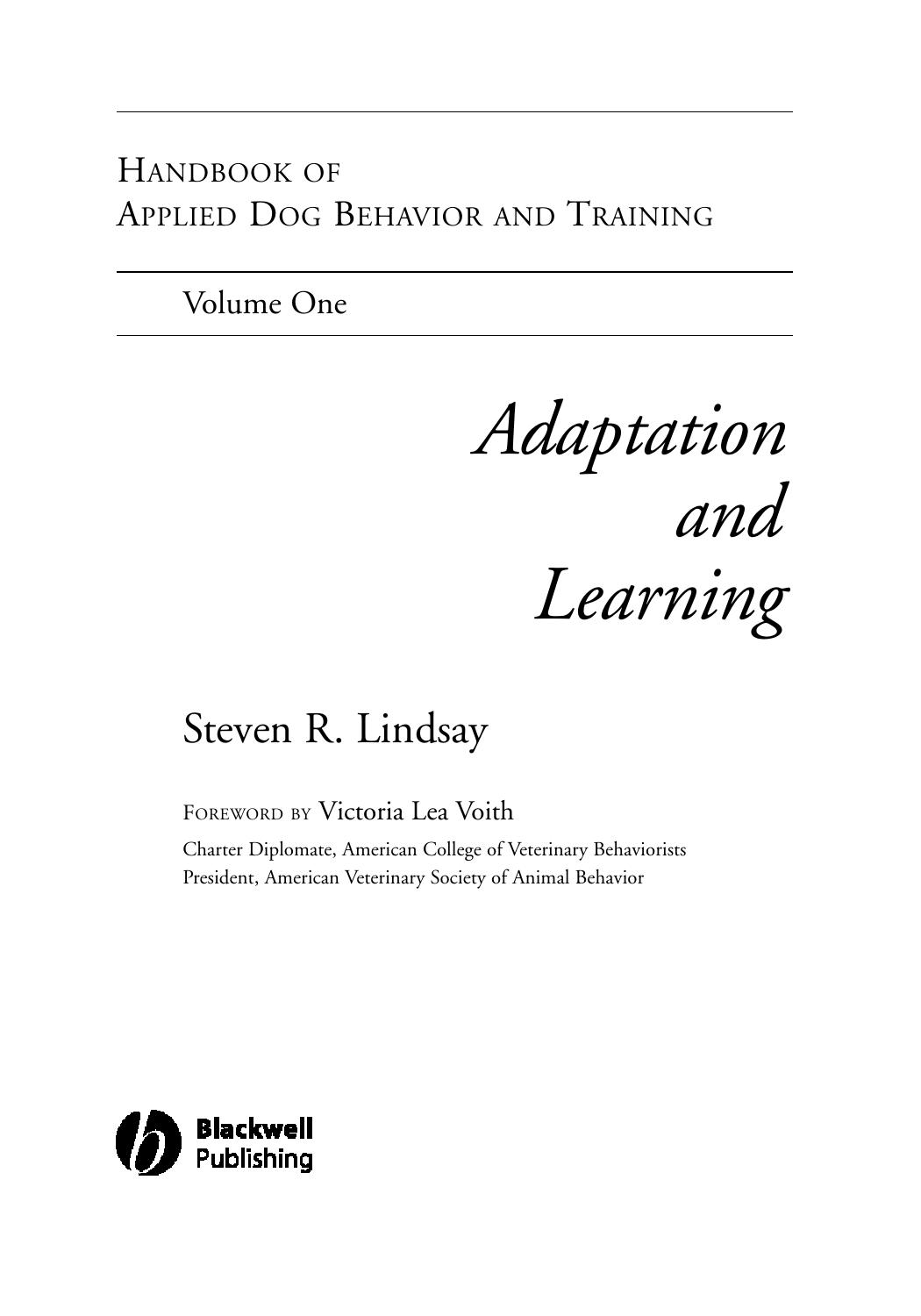Handbook of Applied Dog Behavior and Training, Vol. 1: Adaptation and Learning by Steven R. Lindsay

Author:Steven R. Lindsay
Language: eng
Format: mobi, pdf
Tags: Veterinary Medicine, Small Animal, Medical, General, Pets, Dogs
ISBN: 9780813807546
Publisher: Wiley
Published: 2000-01-29T22:00:00+00:00
206
CHAPTER SIX
ing or harmful target.
Preservative
Preservative
Preparatory reflexes are composed of cen-
preparatory
consummatory
trally organized motivational and evocative
mechanisms arousing an animal to action in
Protective
Protective
the mutually exclusive directions of attraction
preparatory
consummatory
or repulsion. Alimentary reflexes, whether in-
volving eating, urinating, or defecating, de-
FIG. 6.3. Konorski’s (1967) classification of adaptive
pend on the operation of a number of inter-
behavior.
nal preparatory reflexes that provide the
necessary motivational conditions for the spe-
cific consummatory actions to occur. The
cial contact, and reproduction, whereas the
preservative action of eating, for example, is
term protective denotes the set of reflexive be-
composed of preparatory reflexes related to
havioral adjustments that either direct the an-
hunger, which set the motivational occasion
imal away from noxious or dangerous stimuli
for the consummatory reflexes associated
(flight) or cause the animal to attempt to de-
with the ingestion of food. The amount of
stroy them (fight). Preservative reflexes are
hunger experienced by an animal directly af-
appetitive and elicited by attractive stimuli,
fects the magnitude of the consummatory
whereas protective reflexes are defensive and
eating reflex finally expressed. Likewise, elim-
elicited by aversive stimuli. These reflexive
ination is comprised of an interaction of
mechanisms are related to one another along
preparatory and consummatory reflexes. As
an approach-withdrawal continuum based on
the result of pressure-sensitive receptors lo-
a biological optimization of the organism’s
cated in the bladder and bowel, preparatory
well-being and adaptation to the surrounding
reflexes are elicited that set the motivational
environment.
occasions for the consummatory actions of
urinating or defecating.
Preparatory and Consummatory Reflexes
A similar cooperative arrangement be-
tween preparation and consummation medi-
This scheme of reflexive organization is fur-
ates the expression of protective reflexes.
ther subdivided into two sequential and in-
Preparatory protective reflexes involve the es-
terdependent modes of expression that
cape-avoidance of painful or fearful internal
Konorski refers to as preparation and con-
states. Fear is essentially an autonomic re-
summation. Both preservative and protective
sponse preparing the organism with appropri-
reflexes are expressed through these two se-
ate emotional arousal for the occurrence of
quencing modes. The term preparatory de-
aversive stimulation:
notes all the drive and emotional factors
compelling a dog to seek out attractive stim-
There is no doubt that most fear reflexes are
uli or to avoid aversive ones. Consummatory
closely correlated with pain. As a matter of
reflexes include all those reflex actions associ-
fact, every living creature is afraid of pain, and
ated with the adaptive demands made by the
a large part of its behavior is concerned with
environment upon a dog. Preservative con-
developing such preparatory activities as would
prevent the occurrence of painful stimuli. It is,
summatory reflexes include biological actions
however, clear that preventing a noxious stimu-
like salivation, mastication, drinking, and
lus depends upon its anticipation, which is
swallowing. Protective consummatory reflexes
usually accomplished through conditioning.
are composed of both defensive and offensive
(Konorski, 1967:30)
reactions. Defensive reflexes include escape-
avoidance responses and various biological re-
Some fears, however, do not appear to de-
jection reflexes like vomiting, sneezing, spit-
pend on a conditioning process to develop.
ting, shaking, scratching, and blinking.
Such fears are, in the terminology of Selig-
Offensive consummatory reflexes include var-
man (1971), biologically prepared (or hard-
ious forms of aggressive behavior directed to-
wired). Many dogs are innately fearful of
ward the control or destruction of a threaten-
loud, startling noises like fireworks or thun-
Classical Conditioning
207
der. Some are emotionally reactive toward
the adjustment of the pupils and lenses, and
separation or isolation in an unfamiliar place,
converging of the eyes on a single item of fo-
leading to intense preparatory reactions
cused attention.
Download
Handbook of Applied Dog Behavior and Training, Vol. 1: Adaptation and Learning by Steven R. Lindsay.pdf
This site does not store any files on its server. We only index and link to content provided by other sites. Please contact the content providers to delete copyright contents if any and email us, we'll remove relevant links or contents immediately.
Craft Beer for the Homebrewer by Michael Agnew(18140)
Marijuana Grower's Handbook by Ed Rosenthal(3619)
Barkskins by Annie Proulx(3305)
Project Animal Farm: An Accidental Journey into the Secret World of Farming and the Truth About Our Food by Sonia Faruqi(3177)
The Plant Messiah by Carlos Magdalena(2881)
Red Famine: Stalin's War on Ukraine by Anne Applebaum(2873)
0041152001443424520 .pdf by Unknown(2784)
Organic Mushroom Farming and Mycoremediation by Tradd Cotter(2626)
In the Woods by Tana French(2532)
Beer is proof God loves us by Charles W. Bamforth(2370)
7-14 Days by Noah Waters(2361)
Reservoir 13 by Jon McGregor(2240)
Borders by unknow(2227)
Meathooked by Marta Zaraska(2220)
The Art of Making Gelato by Morgan Morano(2216)
Birds, Beasts and Relatives by Gerald Durrell(2175)
Between Two Fires by Christopher Buehlman(2163)
The 7 Habits of Highly Effective People: Powerful Lessons in Personal Change (25th Anniversary Edition) by Covey Stephen R(2139)
The Lean Farm Guide to Growing Vegetables: More In-Depth Lean Techniques for Efficient Organic Production by Ben Hartman(2096)
